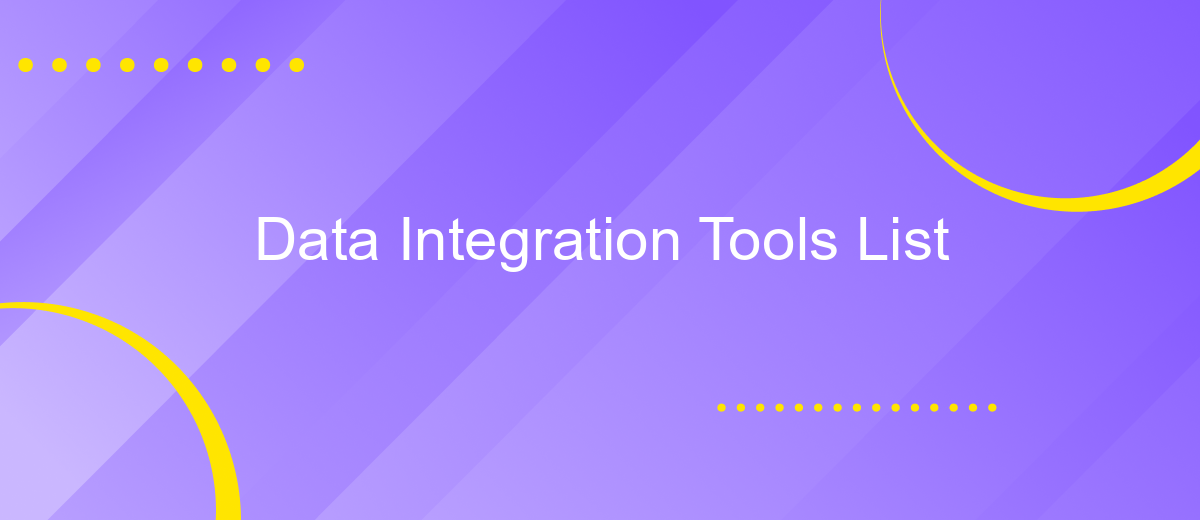Data Integration Tools List
In today's data-driven world, organizations rely heavily on seamless data integration to ensure accurate and timely information flow across various systems. Data integration tools play a crucial role in consolidating data from disparate sources, enhancing decision-making processes, and driving operational efficiency. This article provides a comprehensive list of top data integration tools, highlighting their features, benefits, and use cases to help you choose the best solution for your needs.
Introduction
Data integration tools are essential for organizations seeking to streamline their operations and make data-driven decisions. These tools enable the seamless merging of data from various sources, providing a unified view that is crucial for analysis and reporting. With the growing complexity of data environments, selecting the right integration tool becomes critical.
- Data transformation and cleansing
- Real-time data integration
- Support for multiple data sources
- Scalability and performance
- User-friendly interface
Among the numerous options available, ApiX-Drive stands out as a versatile and user-friendly solution. It simplifies the integration process by allowing users to connect various applications and automate workflows without requiring extensive technical knowledge. By leveraging such tools, businesses can enhance their data management capabilities and drive more informed decision-making.
Tools Overview

Data integration tools are essential for businesses looking to streamline their data management processes. These tools help in combining data from various sources into a unified view, making it easier to analyze and derive insights. They support various functionalities such as data extraction, transformation, and loading (ETL), as well as real-time data integration, ensuring that businesses have access to up-to-date information. Popular data integration tools include Informatica, Talend, and Microsoft SQL Server Integration Services (SSIS), each offering unique features and capabilities to meet diverse business needs.
One notable tool in this space is ApiX-Drive, which simplifies the process of setting up integrations between different applications and services. ApiX-Drive allows users to automate data transfer without requiring extensive technical knowledge, making it accessible for businesses of all sizes. With a user-friendly interface and a wide range of supported applications, ApiX-Drive helps businesses save time and reduce errors associated with manual data handling. By leveraging such tools, organizations can ensure seamless data flow, enhancing their overall efficiency and decision-making capabilities.
Implementation Considerations

When implementing data integration tools, several key considerations must be taken into account to ensure a seamless and efficient integration process. First, it is essential to evaluate the compatibility of the integration tool with existing systems and data formats. This ensures that the new tool can effectively communicate and exchange data without significant modifications.
- Compatibility: Assess whether the tool supports the data formats and protocols used by your existing systems.
- Scalability: Ensure that the tool can handle the volume of data you expect to process, both now and in the future.
- Security: Consider the security features of the tool to protect sensitive data during transfer and storage.
- Usability: Evaluate the user interface and ease of use, particularly for non-technical users.
- Support and Maintenance: Check the level of support and maintenance offered by the vendor, including updates and troubleshooting.
For instance, using a service like ApiX-Drive can simplify the integration process by offering a user-friendly interface and robust support for various data formats and protocols. Its scalability and security features make it a reliable choice for businesses looking to streamline their data integration efforts.
Benefits and Challenges

Data integration tools offer significant benefits by streamlining the process of combining data from various sources into a unified view. They help organizations enhance data quality, improve decision-making, and increase operational efficiency. By automating data workflows, these tools reduce manual intervention and minimize errors.
However, there are also challenges associated with data integration. One of the main issues is the complexity involved in integrating disparate data sources, which can be time-consuming and resource-intensive. Additionally, maintaining data consistency and ensuring real-time data synchronization can be difficult.
- Improved data accuracy and consistency
- Enhanced decision-making capabilities
- Increased operational efficiency
- Reduced manual data handling
- Potential for real-time data updates
Services like ApiX-Drive can simplify the data integration process by providing a user-friendly platform for setting up and managing data workflows. With its wide range of connectors and automation capabilities, ApiX-Drive helps organizations overcome integration challenges and leverage their data more effectively.


Conclusion
In conclusion, the landscape of data integration tools is vast and continually evolving, offering a plethora of options tailored to various business needs. These tools streamline the process of consolidating data from disparate sources, ensuring that organizations can make informed decisions based on comprehensive and accurate datasets. It's crucial to choose a tool that aligns with your specific requirements, whether it's real-time data processing, cloud integration, or user-friendly interfaces.
One noteworthy mention is ApiX-Drive, a service that simplifies the integration process with its intuitive platform. ApiX-Drive allows users to automate workflows and seamlessly connect different applications without the need for extensive technical knowledge. By leveraging such tools, businesses can enhance their operational efficiency, reduce manual errors, and ultimately drive growth. As the demand for efficient data management continues to rise, investing in robust data integration solutions will remain a strategic priority for forward-thinking organizations.
FAQ
What are data integration tools?
Why are data integration tools important?
How do data integration tools work?
What features should I look for in a data integration tool?
Can data integration tools automate the integration process?
Do you want to achieve your goals in business, career and life faster and better? Do it with ApiX-Drive – a tool that will remove a significant part of the routine from workflows and free up additional time to achieve your goals. Test the capabilities of Apix-Drive for free – see for yourself the effectiveness of the tool.

